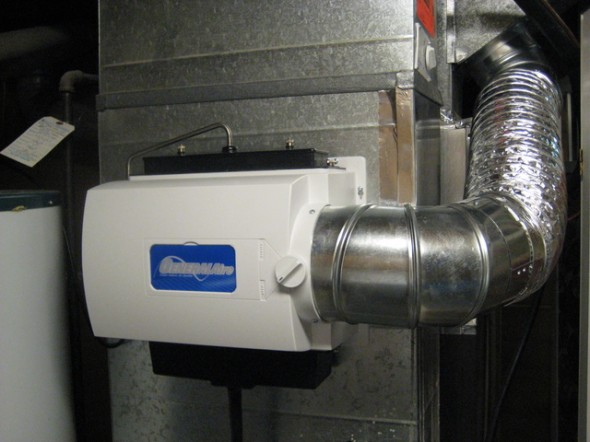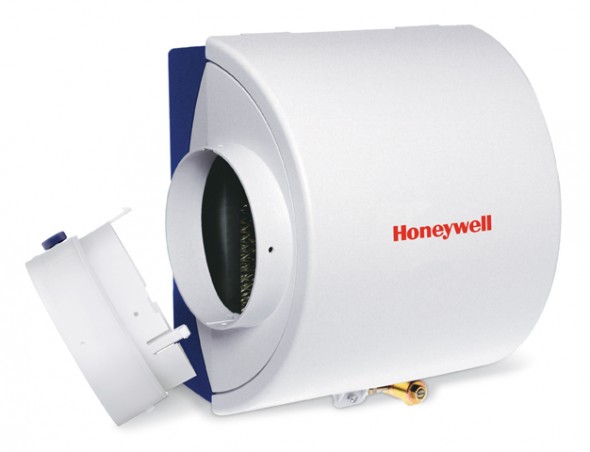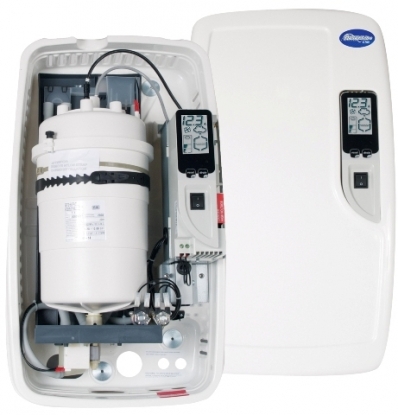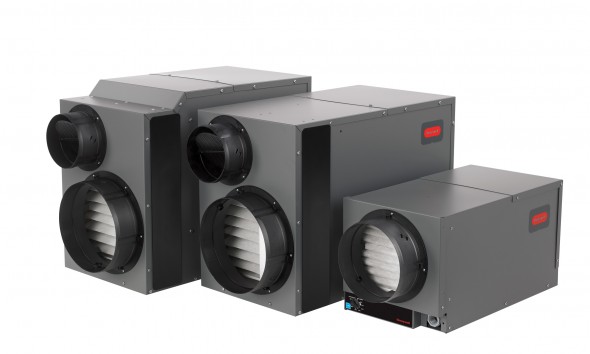Indoor Air Quality in Toronto
Recent statistics report that one in four Canadians now suffer from allergies – and they know how miserable it can be: the itchy nose, scratchy eyes, coughing, and tightness in the chest. Even going indoors has traditionally not alleviated the symptoms and often makes them worse.
Most allergies are caused by pollen or mould spores, but there are up to 72 trillion allergens found in most homes. These can range from pet dander floating in the air to dust mites in bedding, upholstery, and other soft material to VOC (Volatile Organic Compounds) off-gassing from plastics, carpets, furniture, vinyl floors and even dry-cleaned clothing all of which can become airborne and generate irritating waste particles.
And then there’s the dust. The average home generates about 40 pounds of dust per year per 1,400 square feet of space. Add to this the other allergic materials mentioned above and combine it with more modern airtight construction, and you have a recipe for poor indoor air quality that requires a solution “ionic-type” appliances simply cannot deliver.
Fortunately, there are now several highly effective products available that can significantly improve the indoor air quality of your home, business or condo. Both Carrier (Infinity Air Cleaner) and Trane (CleanEffects) now offer flow-through filters that can be installed with your new furnace or as an add-on to your existing system. There are also several types of bypass and portable HEPA filter made by Amaircare that we highly recommend, as well as VANee HRVs (Heat Recovery Ventilators) that can bring fresh air into your home both day and night as well as advanced UV light technology from Sanuvox.
Indoor Air Quality Facts
- The Environmental Protection Agency (EPA) ranks indoor air pollution among the top five environmental risks to public health.
- We spend 90% of our day indoors.
- EPA studies indicate that indoor levels of many pollutants may be up to 25 times higher, and in some instances, more than 100 times higher than outdoor air.
- The occurrence of Asthma has been steadily increasing over the last 20 years
- Asthma is most common during childhood and affects 12% of Canadian children.
- A Canadian household survey found that half of asthmatic school-aged children reported that household pets triggered or worsened their disease yet 41% had a dog and 36% had a cat inside their home. Similarly, 54% of asthmatic children were exposed to second-hand smoke even though smoke was identified as worsening their condition.
- Asthma is the leading cause of absenteeism from school and the third leading cause of work loss.
- Every year in Canada, there are 146,000 emergency room visits due to asthma attacks
- 87% of homeowners are not aware that pollution may be worse inside their homes than outdoors.
- Worldwide, the economic costs associated with asthma are estimated to exceed those of HIV/AIDS combined.
- The World Health Organization estimates that approximately 30% of newly constructed and remodeled facilities have indoor air quality problems.
- According to a study by the Commonwealth of Massachusetts, indoor air contaminants are responsible for half of all illnesses.
- Tobacco smoke actually contains over 4000 compounds, many of which are strong irritants.
- Many ordinary activities such as cooking, cleaning and redecorating can spread indoor pollutants
- The Canadian National Academy of Sciences recently reviewed the evidence for the development of asthma in children and concluded that there is substantial evidence of a causal relationship between exposures to house dust mites and asthma.
- Most homes generate about 40 pounds of dust per year for every 1400 square feet of space.
- About 40,000 dust mites, a common cause of household allergies, can be found in an ounce of dust.
- Even a spotless home can allow indoor pollutants to flourish. Bathrooms, damp basements, and even carpets and furniture are often the prime causes.
Central Humidifiers

During the heating season the average un-humidified, forced-air heated home may have a Relative Humidity (RH) as low as 15%. Amazingly, this is less than half the average RH in the Sahara desert. The ideal indoor RH depends on outside temperatures and are indicated here:
| +40°F /4.4°C | 45% |
| +30°F /-1.1 | 40% |
| +20°F /-6.6 | 35% |
| +10°F /-12.2 | 30% |
| 0°F /-17.8 | 25% |
| -10°F /-23.3 | 20% |
The amount of humidity required in a home is also dependent on the way it is constructed. A well insulated home with vapor barriers in walls, ceilings and slabs with newer windows may only need three gallons of additional moisture per day to maintain a comfortable relative humidity. An older home of similar size, but with greater air leakage, may require five times as much moisture each day to feel comfortable.
The most common type of central humidifier is a bypass flow-through style. This type of humidifier is used with a forced air system. A pipe brings water directly to an electrically-controlled valve at the top of the humidifier. Air passes through an aluminum “biscuit”, (often called a pad), which is similar to a piece of extremely coarse steel wool. The biscuit has a coating of a matte ceramic, resulting in an extremely large surface area within a small space. When there is a call for heat, the humidistat opens a valve and causes a spray of water onto the pad. Hot air passes through the pad, causing the water to evaporate and be carried into the building. We install bypass humidifiers from most major manufacturers including: Generalaire, Honeywell, Carrier, Trane & York. This type of system only functions when there is a call for heat.

Another type of central humidification system is a steam humidifier. These types of humidifiers are installed on forced air systems in homes where there is a high sensitivity to dryness, or simply where there is greater demand for humidity. We will typically install units by Generalaire or Honeywell. These systems can often be set up to run with the fan on your furnace.
For homes with radiators and hot water heating systems, we install a stand-alone humidification system made by Aprilaire. The unit is typically installed in a laundry room and a vent is run up to a single outlet on the main floor. This unit is a highly effective way of getting humidity into a home without ductwork.

It is important to keep in mind that humidity levels in a home are extremely difficult to balance or control. Every time a door is opened in the winter the humidity flows out. The rule of thumb that is often used in older Toronto homes is to set the humidifier to a certain level and then monitor moisture build up on the windows. If you notice moisture on the windows you need to turn down your humidification system. It is an unscientific, but highly practical method.
Central De-Humidifiers
Do you struggle with a damp, musty basement? Are you forced to run a portable dehumidifier in a vain attempt to control your basement humidity? If you do, you are not alone. Many older Toronto homes have damp basements that can lead to mildew, mould and the associated respiratory health issues that may be caused by these conditions. Portable dehumidifiers are expensive to run, require constant monitoring to empty out water, and most units simply cannot remove enough moisture to have a significant impact. The Honeywell TrueDRY is central dehumidification unit that we have successfully used as a stand-alone solution for moisture issues in many Toronto homes.

Key features at a glance:
- Superior, stand-alone dehumidification for basements
- Removes up to 65 pints of moisture per day
- Can be centrally ducted for whole-house dehumidification or unducted for moisture control in attics or smaller crawl spaces
- Merv 11 media filtration improves performance life, efficiency and indoor air quality
- Top or side ducted exhaust allows for more installation applications
- Onboard dehumidistat allows the unit to run without additional wiring
- Operates with R-410A refrigerant
- 5-year parts warranty
Indoor Air Quality FAQ
- I Thought pollution was outside. Why should I be worried about my indoor air quality?
- What kinds of things are in my home that might be affecting my family’s health and comfort?
- What is the Clean Air Delivery Rate (CADR)?
- I keep my home spotless. Could the air in my home still not be clean?
- What is HEPA?
- How are the products you can install different from the air cleaners I see advertised on TV?
- Are there solutions for individual rooms, or condos that you would recommend?
- Do I have to change my filters and clean my indoor air quality equipment?
1.
We spend 90% of our time indoors and due to more efficient insulation (creating more airtight houses), our homes are now better at trapping potentially irritating particles inside the home. With rising numbers of people suffering from allergies and asthma, indoor air quality has become more and more important to our general health and well being.
2.
A wide range of particulate matter exists within a home:
- Dust
- Animal hair & dander
- Pollen
- Dust mites
- Mold spores
- Smoke
- Cooking grease
- Bacteria
- Lint
As well, imbalanced indoor humidity levels can make the situation worse.
3.
CADR is recognized by the Environmental Protection Agency as a fair and objective measure of various air cleaner technologies. CADR provides the number of cubic feet of clean air a unit delivers each minute. A higher CADR means a greater amount of clean air is being delivered to your home.
4.
Yes. It is impossible to completely combat the amount of dust generated in the average home. While regular cleaning is an excellent measure to reduce exposure to irritants and pollutants, cleaning products themselves can contribute to poor indoor air quality.
5.
HEPA refers to a type of air filter. It is an acronym for “high efficiency particulate air [filter]” (as officially defined by the United States Department of Energy). This type of air filter can theoretically remove at least 99.97% of dust, pollen, mold, bacteria and any airborne particles with a size of 0.3 micrometers (µm) at 85 liters per minute (L/min). The diameter specification of 0.3 µm responds to the worst case; the most penetrating particle size (MPPS). Particles that are larger or smaller are trapped with even higher efficiency. Using the worst-case particle size results in the worst-case efficiency rating (i.e. 99.97% or better for all particle sizes).
6.
It basically comes down to airflow. The greater the volume of air we can move through a HEPA or HEPA-equivalent filter the higher the Clean Air Delivery Rate (CADR) in your home, and “ionic” devices simply do not move enough air. The figure below give you an idea about how crucial air flow is when choosing an indoor air quality product:
| Type of Air Cleaner | Clean Air Delivery Rate (CADR) | |
| Carrier Infinity & Trane CleanEffects | 1000+ | |
| Amaircare HEPA whole house bypass | 1000+ | |
| Whole house electronic air cleaner | 660+ | |
| Whole house 5 inch Media filter | 240+ | |
| Typical portable HEPA appliance | 150+ | |
| Standard 1 inch filter | 12+ | |
| Typical Ionic-type appliance | 10+ |
7.
Absolutely. Amaircare makes a range of portable HEPA units capable of moving high volumes of air through their filters making them ideal as additional protection in baby nurseries, children’s bedrooms, or condos where other indoor air quality products may not be able to be installed. These portable units are not available in stores and have considerably lower running costs than over-the-counter products because of more efficient motors.
8.
If you’re asking this question you probably already know the answer. Filters get clogged, and all equipment should be checked, cleaned and maintained on a regular basis. There is no magic bullet that is simply going to look after itself, but the products we suggest will go a long way to significantly improving the quality of living in your home. We’re a family owned and operated business and both members of our family and our staff use these products in our own homes.


